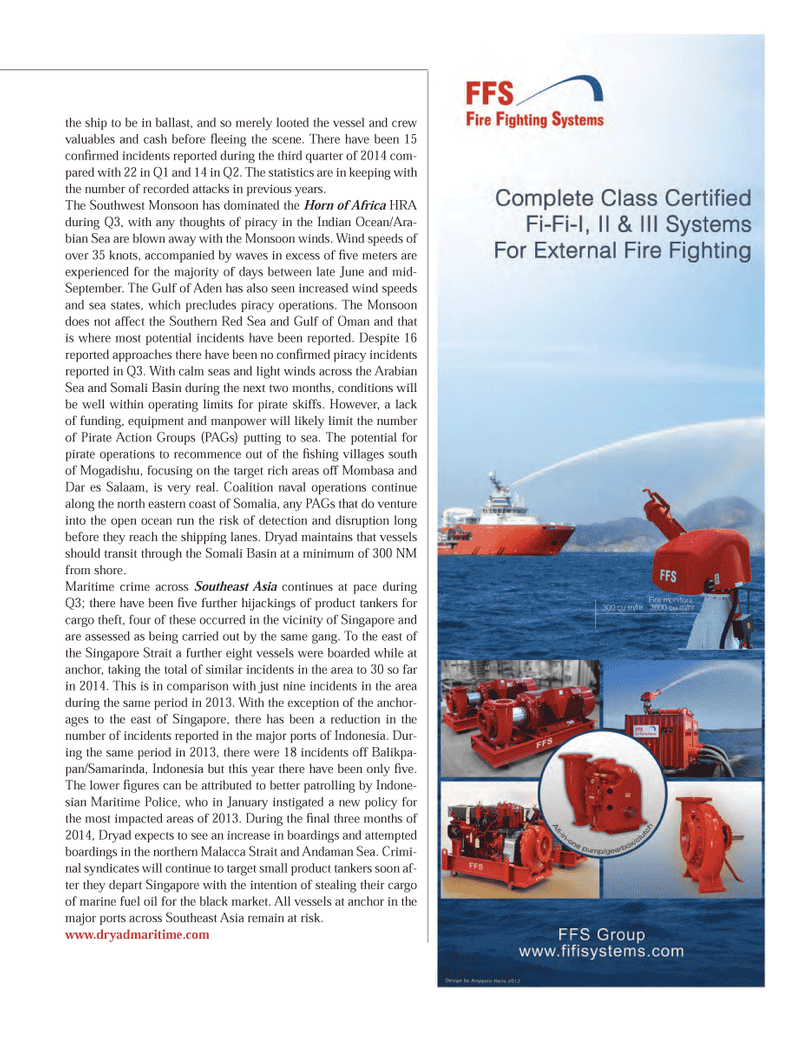
Page 21: of Maritime Logistics Professional Magazine (Q4 2014)
Read this page in Pdf, Flash or Html5 edition of Q4 2014 Maritime Logistics Professional Magazine
the ship to be in ballast, and so merely looted the vessel and crew valuables and cash before ß eeing the scene. There have been 15 conÞ rmed incidents reported during the third quarter of 2014 com- pared with 22 in Q1 and 14 in Q2. The statistics are in keeping with the number of recorded attacks in previous years. The Southwest Monsoon has dominated the Horn of Africa HRA during Q3, with any thoughts of piracy in the Indian Ocean/Ara- bian Sea are blown away with the Monsoon winds. Wind speeds of over 35 knots, accompanied by waves in excess of Þ ve meters are experienced for the majority of days between late June and mid- September. The Gulf of Aden has also seen increased wind speeds and sea states, which precludes piracy operations. The Monsoon does not affect the Southern Red Sea and Gulf of Oman and that is where most potential incidents have been reported. Despite 16 reported approaches there have been no conÞ rmed piracy incidents reported in Q3. With calm seas and light winds across the Arabian Sea and Somali Basin during the next two months, conditions will be well within operating limits for pirate skiffs. However, a lack of funding, equipment and manpower will likely limit the number of Pirate Action Groups (PAGs) putting to sea. The potential for pirate operations to recommence out of the Þ shing villages south of Mogadishu, focusing on the target rich areas off Mombasa and Dar es Salaam, is very real. Coalition naval operations continue along the north eastern coast of Somalia, any PAGs that do venture into the open ocean run the risk of detection and disruption long before they reach the shipping lanes. Dryad maintains that vessels should transit through the Somali Basin at a minimum of 300 NM from shore.Maritime crime across Southeast Asia continues at pace during Q3; there have been Þ ve further hijackings of product tankers for cargo theft, four of these occurred in the vicinity of Singapore and are assessed as being carried out by the same gang. To the east of the Singapore Strait a further eight vessels were boarded while at anchor, taking the total of similar incidents in the area to 30 so far in 2014. This is in comparison with just nine incidents in the area during the same period in 2013. With the exception of the anchor- ages to the east of Singapore, there has been a reduction in the number of incidents reported in the major ports of Indonesia. Dur- ing the same period in 2013, there were 18 incidents off Balikpa- pan/Samarinda, Indonesia but this year there have been only Þ ve. The lower Þ gures can be attributed to better patrolling by Indone- sian Maritime Police, who in January instigated a new policy for the most impacted areas of 2013. During the Þ nal three months of 2014, Dryad expects to see an increase in boardings and attempted boardings in the northern Malacca Strait and Andaman Sea. Crimi- nal syndicates will continue to target small product tankers soon af- ter they depart Singapore with the intention of stealing their cargo of marine fuel oil for the black market. All vessels at anchor in the major ports across Southeast Asia remain at risk. www.dryadmaritime.com 18-33 Q4 MP2014.indd 2118-33 Q4 MP2014.indd 2111/17/2014 11:14:58 AM11/17/2014 11:14:58 AM

 20
20

 3rd Cover
3rd Cover
